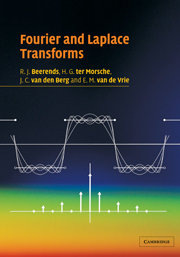Part 5 - Discrete transforms
Published online by Cambridge University Press: 05 June 2012
Summary
INTRODUCTION TO PART 5
In the previous chapters we have seen how the Fourier transform of a continuous-time signal can be calculated using tables and properties. However, it is not always possible to apply these methods. The reason could be that we only know the continuous-time signal for a limited number of moments in time, or simply that the Fourier integral cannot be determined analytically. Starting from a limited set of data, one then usually has to rely on numerical methods in order to determine Fourier transforms or spectra. To turn a numerical method into a manageable tool for a user, it is first transformed into an algorithm, which can then be processed by a digital computer. The user then has a program at his/her disposal to calculate spectra or Fourier transforms. Calculating the spectrum of a continuous-time signal using a computer program can be considered as signal processing. When an algorithm for such a program is studied in more detail, then one notices that almost all calculations are implemented in terms of numbers, or sequences of numbers. In fact, the continuous-time signal is first transformed into a sequence of numbers (we will call this a discrete-time signal) representing the function values, and subsequently this sequence is processed by the algorithm. One then calls this digital signal processing. It is clear that because of the finite computing time available, and the limited memory capacity of a digital computer, the spectrum can only be determined for a finite number of frequencies, and is seldom exact.
- Type
- Chapter
- Information
- Fourier and Laplace Transforms , pp. 337 - 339Publisher: Cambridge University PressPrint publication year: 2003

